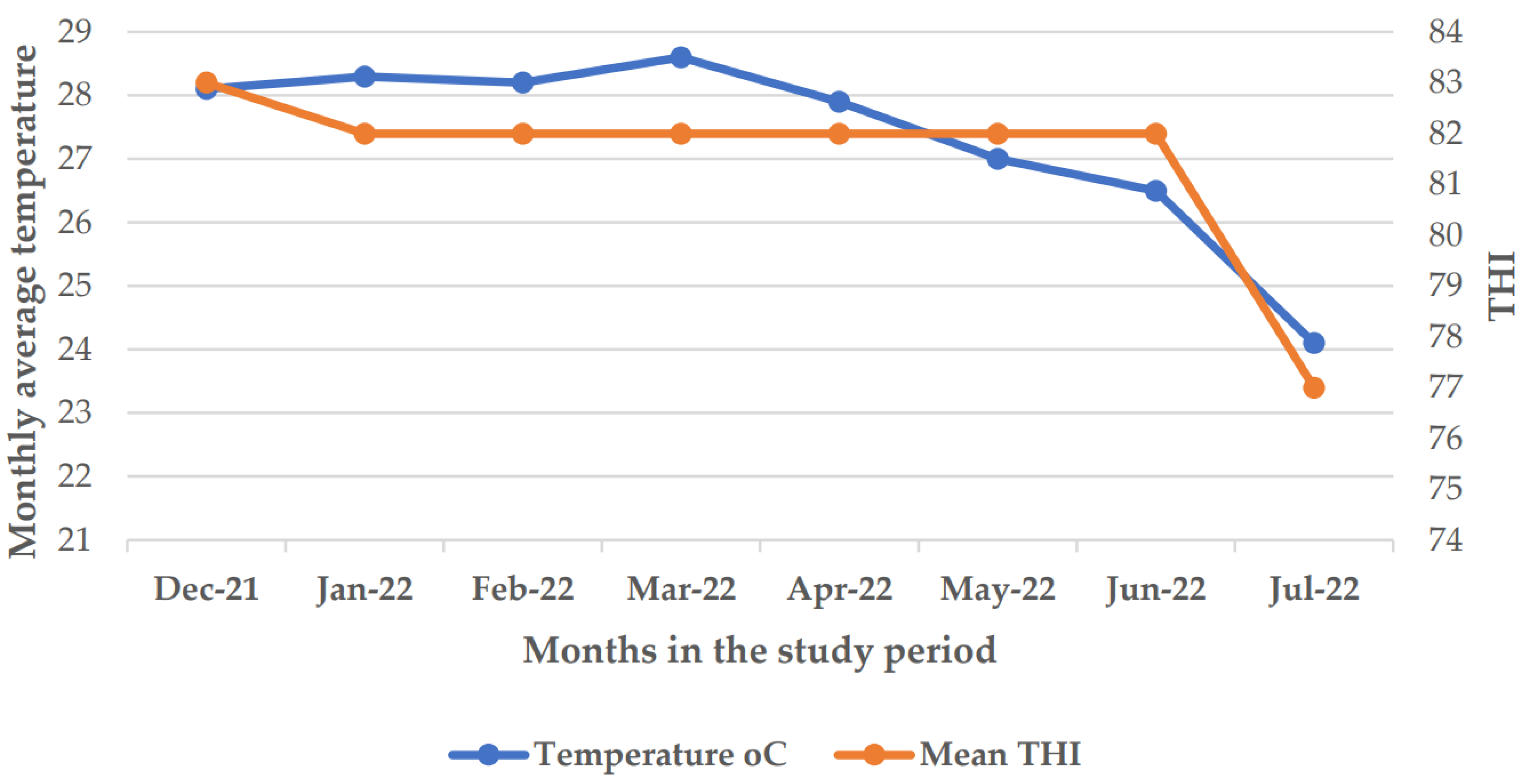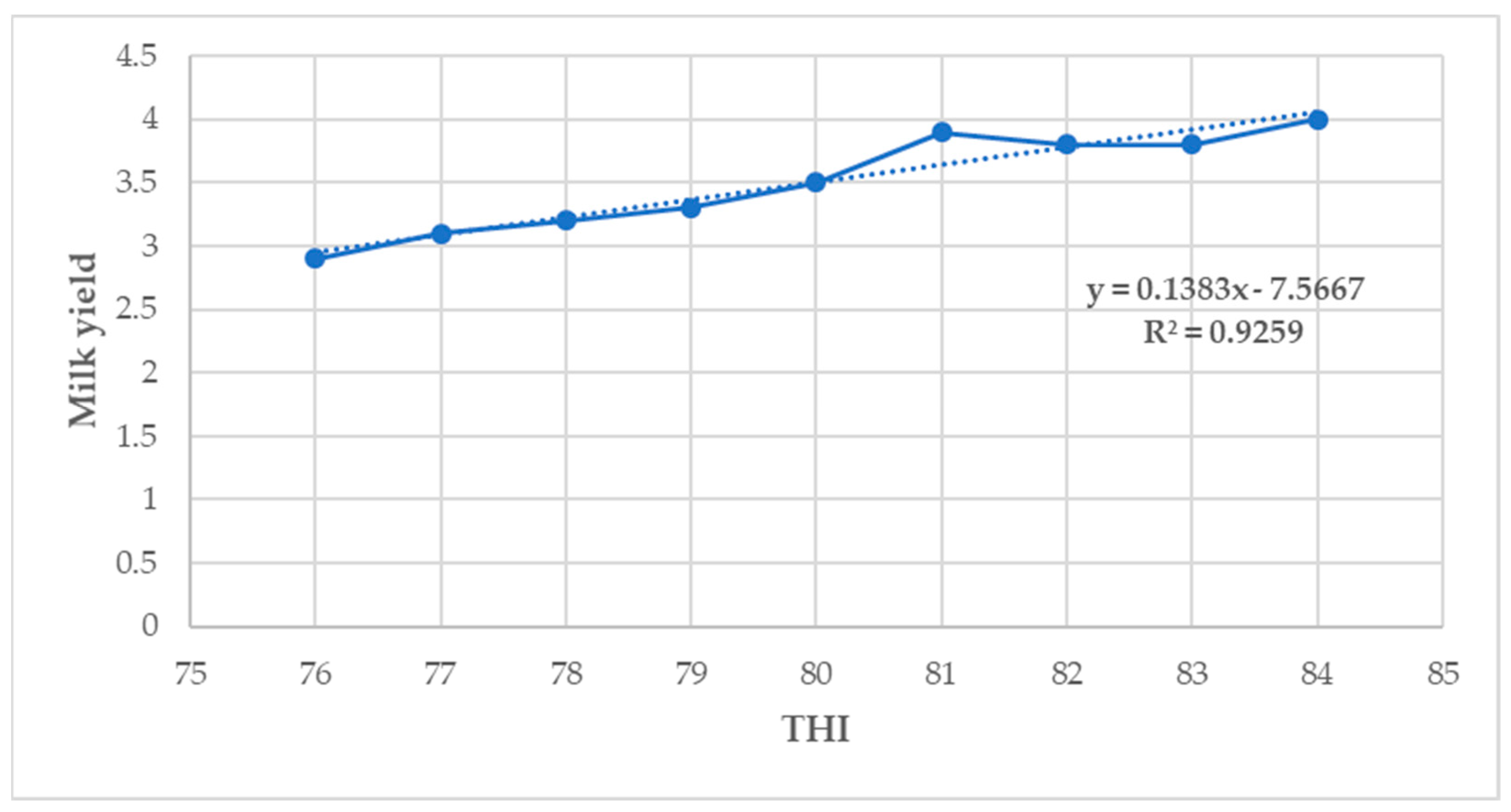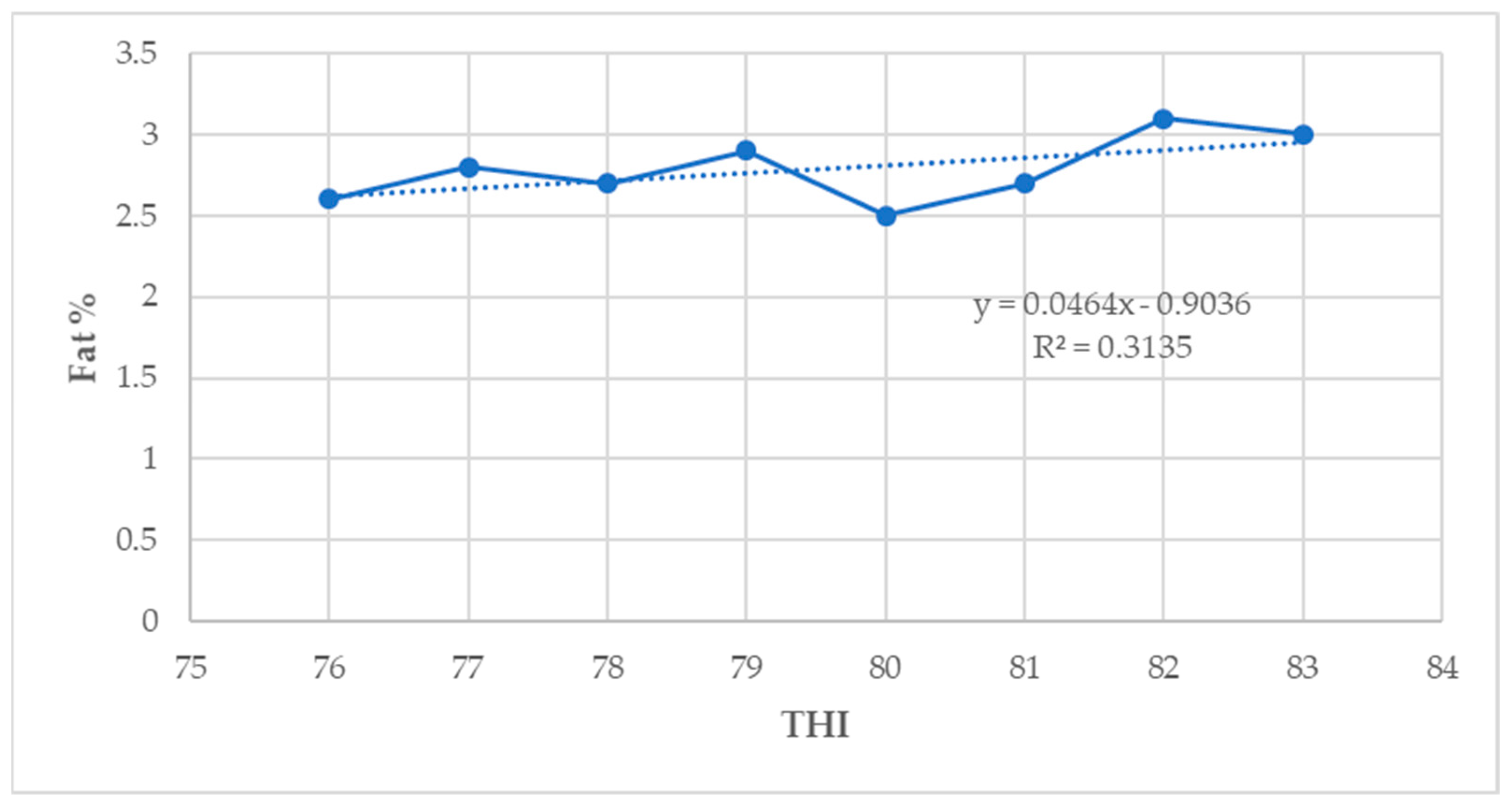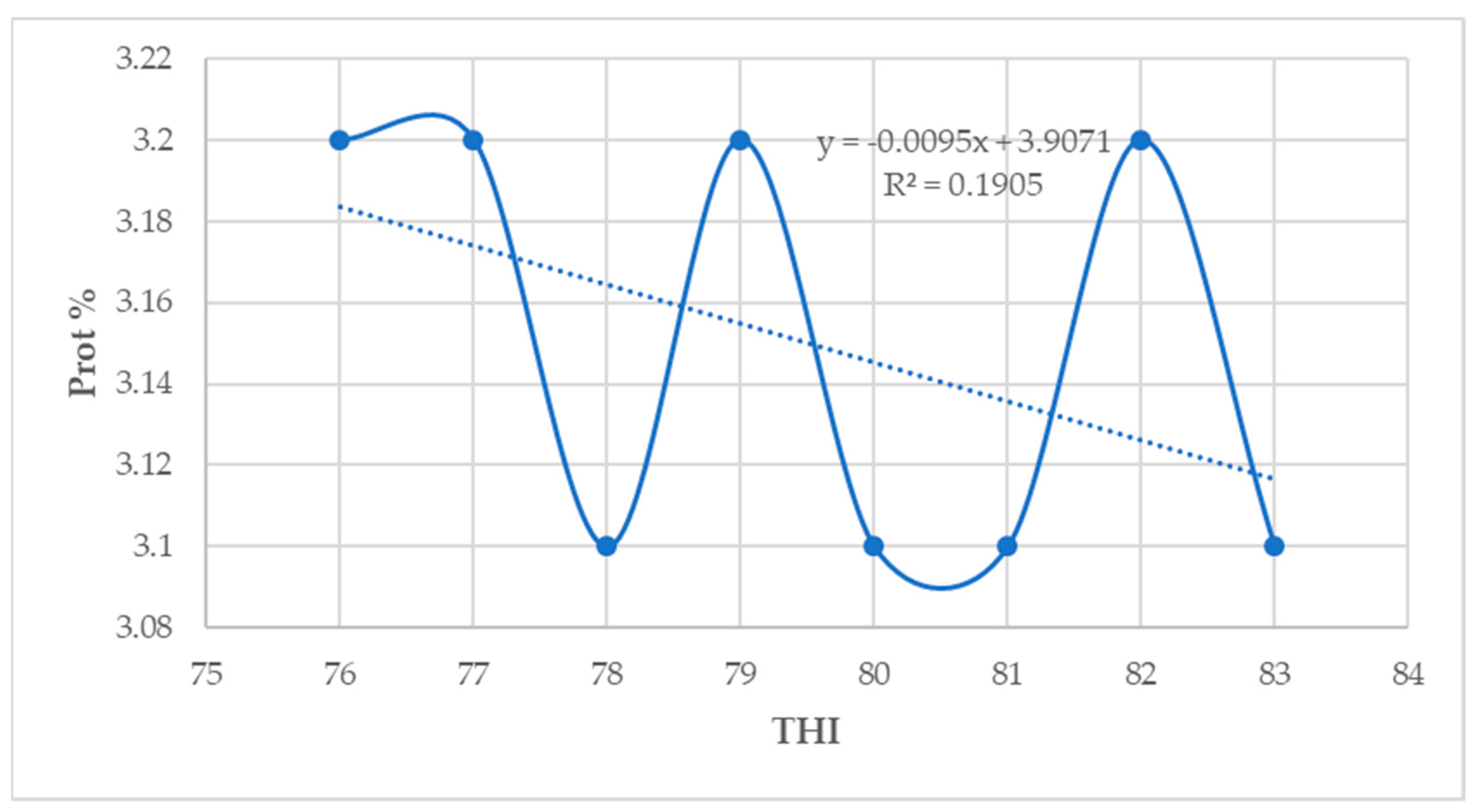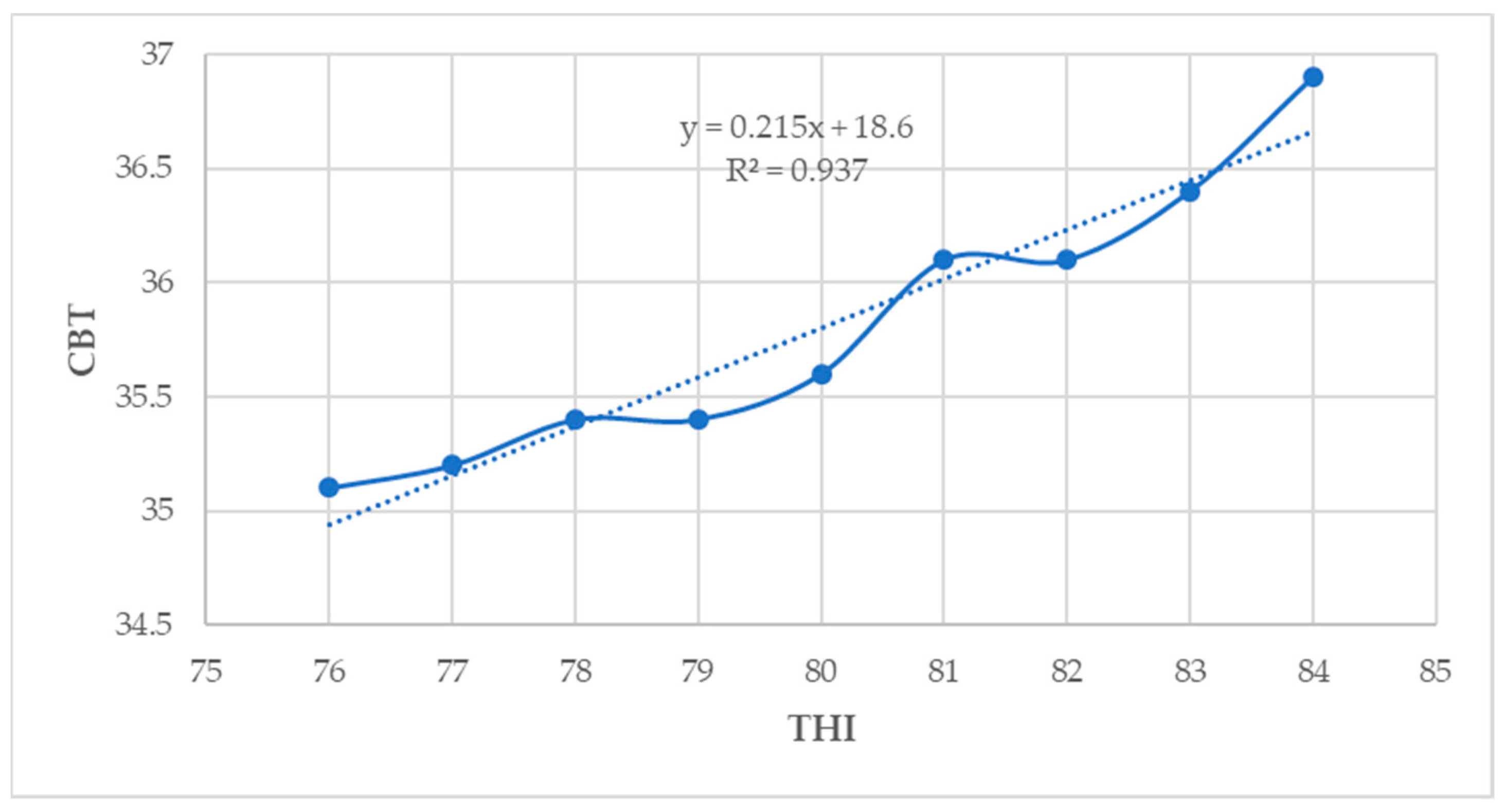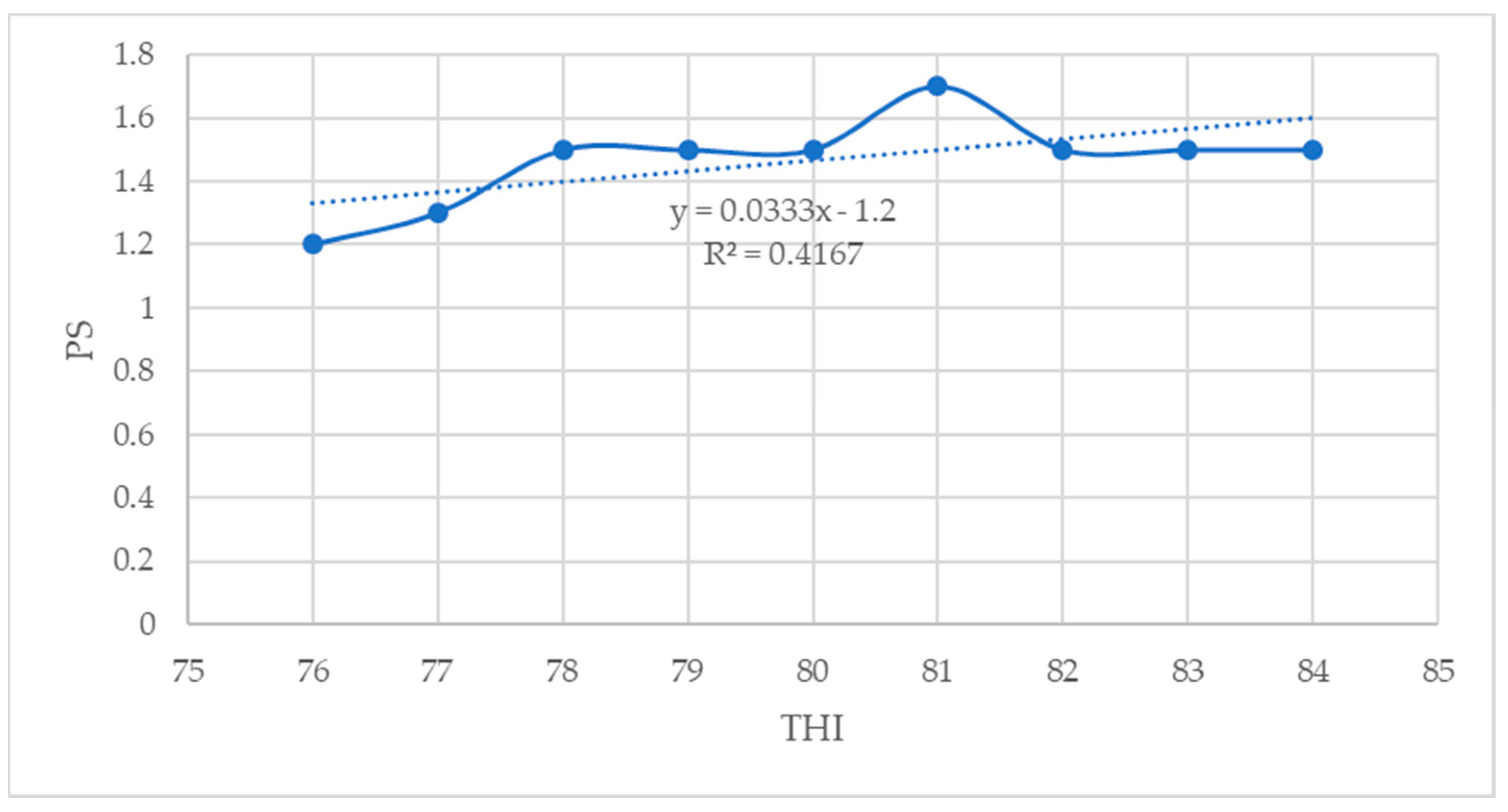In this study, the results show that the mean ambient temperature and THI values in the hot season (January–February) were higher than those in the cool season (June–July). On the other hand, the mean relative humidity in the cool season was higher than that in the hot season. Generally, the observed mean THI values were high in such a way that they can cause HS to the animals. Similar findings were reported by Lim et al. [
45] in their study about HS effects on the milk production parameters of Holstein and Jersey lactating dairy cows in South Korea. Some studies reported that the dairy cow’s thermoneutral zone ranges between 5 °C and 25 °C but can fall to the range from 0.5 °C to 20 °C and 60% to 80%RH, although this varies depending on the production status, feed type, acclimatization level, and climatic conditions [
18,
45]. Habimana et al. [
18] reported that when the THI exceeds 72, dairy cows begin to experience HS. In the present study, a decline in milk yield and composition parameters was observed when the THI values ranged from 77 to 84. In Rwanda, Niyonzima et al. [
30] reported THI values ranging from 63.3 to 84.6 with an average of 75.8 THI as the HS threshold for the milk yield decline. This is in agreement with the THI thresholds obtained in this study. In Florida (USA), Fabris et al. [
46] reported THI values of above 68 as HS thresholds for lactating dairy cows. In India, Velayudhan et al. [
47] reported THI values of 72–75 as the most favorable for lactating dairy cows in the tropical region of Bengaluru because of the maximum milk production obtained. In the smallholder farms of Tanzania, Ekine-Dzivenu et al. [
19] reported a THI of 76 as the HS threshold. The seasonal changes in THI thresholds and the associated variations in the milk yield, milk composition, and physiological parameters observed in this study could be associated with variations in weather conditions over the months. These climatic variations lead to alterations in the quality and quantity of the diet provided to dairy cattle [
19].
4.1. Heat Stress Effects on the Milk Yield and Composition Parameters of Lactating Holstein Friesian Crossbred Dairy Cows
The results in the present study indicate that the milk yield and fat percentage increased slightly, whereas the milk protein, lactose, and solids–not–fat percentages decreased, when the THI values increased from 76 to 84. One possible reason for this could be that a slight increase in the milk yield as the THI increased implies that there was very little influence of THI values above the threshold on milk production [
30]. These results are inconsistent with the findings by Sungkhapreecha et al. [
48] in Thailand, who reported that the milk yield declines when the THI reach 76. In Australia, Talukder et al. [
43] reported that the daily milk yield increased as the THI increased up to a THI value of 65 and remained fairly constant until 85, decreasing afterwards. This is in agreement with the findings of this study. In Brazil, Stumpf et al. [
49] indicated that an increase in THI thresholds generally causes a decline in milk production parameters, which is in contrast with the findings of this study. Under the Mediterranean climatic conditions of Tunisia, Bouraoui et al. [
20] reported a decline in the milk fat percentage of 0.34% and a 21% decline in the milk yield when the THI values increased from 68 to 78 for lactating Holstein Friesian dairy cows. In Rwanda, Niyonzima et al. [
30] reported a decrease in the milk yield for lactating Holstein crossbred dairy cows when the THI thresholds were above 76, which is not in agreement with the findings of this study. The decline in milk yield traits during HS could be the result of a reduction in the feed intake and decreased nutrient uptake by the portal drained viscera of dairy cows [
19,
20,
27]. In this study, HS reduced the milk yield and milk composition parameters when the THI increased from moderate to high THI values for both HF50 and HF75 lactating dairy cows. There was a higher decrease in milk composition parameters for HF75 than for HF50 lactating dairy cows when the THI values increased from moderate to high THI thresholds, an indication that the later are relatively more heat-tolerant than the HF75. In Brazil, Alfonzo et al. [
50] reported that Girolando-Holstein Friesian cows with a 75% gene level (GH75) were less tolerant to heat compared with GH50 cows, which is in agreement with the findings of this study.
In Germany, Lambertz et al. [
7] reported a milk fat and protein decline as the THI increased from 60. Garcia et al. [
51] indicated that under HS conditions, the higher fat content in dairy cows’ milk is caused by an increase in free fatty acids during the negative energy balance, whilst a decline in milk protein is due to a lower synthesis of casein formation enzymes in the mammary gland. In the study by Lambertz et al. [
7] across Holstein Friesian dairy genotypes, the milk protein, lactose, and solids-not-fat declined when the THI changed from moderate to high THI values. This is in agreement with the findings of this study. The findings of this study also partially agree with those reported by Corazzin et al. [
15], who observed an increase in fat and protein percentages but no increase in the lactose percentage. This shows that HS decreases the protein content of milk without affecting the fat percentages. Also, the results in the present study concur with the results reported by Bouraoui et al. [
20], who found that HS reduced milk fat and protein percentages when the season changed from spring to summer. Generally, HS effects on milk fat and protein percentages are largely non-consistent, as reported by Corazzin et al. [
15]. Rhoads et al. [
52] reported a reduction in the milk protein percentage of 0.13% during HS conditions. Moreover, individual animal differences and trait responses to HS are expected owing to animal-related factors like the breed and physiological responses such as the age, production status, feed intake, and animal behaviors [
33]. The decline in the milk protein percentage detected in this study is in agreement with the results reported by Bouraoui et al. [
20] and Rhoads et al. [
52]. The milk protein concentration is determined by the energy absorption or the energy content of the diet, and its noneffective supply causes a decline in milk protein percentages [
7]. It is well recognized that HS decreases feed intake [
17,
28], but the feed intake in animals grazing on pasture declines owing to the feed shortage during hot weather conditions [
30]. The lactating Holstein Friesian crossbred dairy cows in this study were freely grazing on pasture, and the dry matter intake from the pasture was not recorded. Therefore, the lower milk yield observed in this study was a result of the reduced feed intake from the pasture combined with the physiological and metabolic effects of HS [
7,
30].
On the other hand, the genotype, parity, and months of lactation also influenced the milk yield and composition parameters. Corazzin et al. [
15] reported that the higher percentage of protein and fat observed in the milk of heat-stressed dairy cattle could be the result of a decline in milk production and a subsequent increased concentration of protein and fat in addition to possibly greater non-protein nitrogen contents in the milk produced by dairy cows under HS conditions. Furthermore, the results of the current study show that parity influenced the milk yield and composition parameters such that the milk yield decreased from the second parity to the third parity. Similarly, the milk composition parameters declined from the second to third parities. This could be due the differences in feeding rates, as primiparous dairy cows eat more slowly than multiparous ones during the peak lactation [
53]. Additionally, Moore at al. [
44] reported that high-producing lactating dairy cows such as multiparous lactating dairy cows show major heat sensitivity owing to increased intrinsic metabolic heat production compared to young lactating dairy cows in the second parity. In the study by Sabek et al. [
54], theparity and lactation month had negative effect on the milk yield, fat, protein, lactose, and solids–not–fat percentages, which is in agreement with the findings of this study.
Regarding the genotype and THI interaction, the findings showed different trends for the milk yield and composition of HF50 and HF75 lactating dairy cows when the THI values increased. There was a marked difference between HF50 and HF75 in the milk yield at THI values of 76 to 78. The milk yield declined and increased in HF75 and HF50 lactating dairy cows, respectively, when the THI values increased from moderate to high. Regarding milk composition parameters, HF50 showed higher contents of fat, protein, lactose, and solids–not–fat percentages than HF75. Nevertheless, the fat % declined when the THI changed from moderate to high THI values in both HF50 and HF75, whilst no reduction was observed for protein %. No large difference was observed for the lactose percentage in both HF50 and HF75 when the THI changed from low to high THI values. A large decline in solids–not–fat was observed in HF50 compared to that in HF75 when the THI changed from moderate to high THI values. These findings are in agreement with those reported by Stumpf et al. [
49], who observed a greater decrease in milk production for HF75 than for HF50 when the THI values increased from 79.2 to 80.32. The magnitude of the milk yield decline and the alteration of milk composition parameters including fat, protein, lactose, and solids–not–fat percentages as a result of HS are influenced by various mechanisms at different lactation stages, and the mammary gland of lactating dairy cows respond differently to HS [
27].
Parity and THI interaction influenced the milk yield and composition such that the milk yield decreased when the THI increased for the cows in both the second and third parities. These findings concur with those reported by Song et al. [
55]. Lactating Holstein Friesian crossbred dairy cows in the second parity showed a higher milk yield and composition compared to those in the third parity, which indicates that multiparous lactating dairy cows in the second parity are highly tolerant compared to multiparous dairy cows in the third parity. In the study by Ouellet et al. [
56], lactating dairy cows in all parities were stressed by HS and responded by showing a significant decline in milk protein percentages; this is inconsistent with the results of this study. Song et al. [
55] indicated that primiparous lactating dairy cows are lighter than multiparous ones; thus, the ratio of the surface area to the volume is slightly higher, and this predisposes them to heat loss. Moreover, limited studies have explored the relationship between the lactation stages of dairy cows and THI values [
57]. In this study, it was observed that lactating Holstein Friesian crossbred dairy cows in the third month of lactation showed a significant decline in the milk yield compared to those in the second month of lactation. However, the reverse was observed for fat, protein, lactose, and solids–not–fat percentages, whereby significant effects of HS were observed in terms of reduced milk composition traits for the cows in the second month of lactation compared to those in the third month of lactation.
Lactating Holstein Friesian crossbred dairy cows in the third month of lactation were highly affected by HS compared to those in the second month of lactation, as they showed a higher decline in the milk yield when the THI increased from low to high THI values. On the other hand, lactating Holstein Friesian crossbred dairy cows in the second month of lactation showed a higher decline in milk protein, lactose, and solids–not fat percentages compared to those in the third month of lactation as the THI increased from low to high THI values. This is in agreement with the findings of Lambertz et al. [
7], who reported that the major effects of HS on the milk yield, fat, and protein percentages are identified in later lactation. Furthermore, the findings of the current study are supported by results from other studies, which reported that lactating dairy cows in the early stages of lactation are highly affected by HS in terms of productivity [
42,
57]. In Australia, Osei-Amponsah et al. [
27] observed a significant effect of the stage of lactation on the daily milk yield, fat, and protein percentages, which is in agreement with the findings of this study. In a pasture–based system, Osei-Amponsah et al. [
27] reported an increase in the milk fat % and protein % by 3% and 2%, respectively, when the THI changed from low to high THI values. The reduction in milk fat, protein, lactose, and solids–not–fat percentages is mainly influenced by the adverse effects of hot weather conditions on the synthesis of these milk constituents in the dairy cow mammary gland [
42]. There are substantial milk yield losses induced by HS at any stage of lactation of dairy cows. Thus, the cooling of lactating dairy cows when the THI thresholds range between 77 and 84 is necessary through the use of trees in the farms, shading, the provision of drinking water, and the supplementation of concentrate during milking, among others, to minimize the decline in the milk yield observed in the afternoon and hot season. However, the different cooling approaches should be done with consideration of the production cost of the cooling technologies applied [
16]. Under warm and humid conditions, dairy farmers could improve the milk yield and avoid fluctuations in the milk composition in different seasons through nutritional supplementation and the manipulation of feeding practices. Furthermore, the provision of fans, sprinklers, shade, barns, and trees, which enhance passive ventilation, could improve body heat loss, increase the dry matter intake of cows, and, hence, improve the dairy cattle milk composition [
18,
28,
58].
4.2. Heat Stress Effects on the Physiological Parameters of Lactating Holstein Friesian Crossbred Dairy Cows
Studies have shown that an RR greater than 60 breaths/min indicates HS when dairy cow use evapotranspiration as the key mechanism for losing body temperature [
51]. In the present study, when THI values increased from 76 to 84, the lactating Holstein Friesian crossbred dairy cows responded by increasing the RR. Also, when the THI values increased from 76 to 84, there was an increase of 0.4 °C for CBT and RT, and there were 11 breaths per min. Similar patterns of responses to HS were observed in the study conducted in Tunisia by Djelailia et al. [
59]. In their study, HS altered RT, RR, and HR such that a daily increase of 1.2 °C was observed when the THI values increased from 55 to 78, while the HR and RR increased by 3 beats per min and 35 breaths per min, respectively. The physiological responses to HS observed in this study are an adaptive mechanism initiated by lactating Holstein Friesian crossbred dairy cows in an attempt to restore their thermal balance [
59]. The CBT of lactating dairy cows varies many times, as it is a crucial tool for regulating body temperature and relies on the peripheral blood flow [
45]. When a lactating dairy cow wants to reduce its body temperature, its body heat is transported from the core of the body to the skin by blood; thus, the blood flow to the skin will rise, thereby increasing the skin temperature [
45].
The RT is considered to be a good indicator of deep CBT, although there are significant changes among various parts of the core body at different scales of the day [
45]. In this study, significantly higher CBT and RT values were recorded when the THI values were above 82–84. These results are in agreement with those reported by Garcia et al. [
51] in Brazil, who found a significant effect of THI on RT and RR. Also, the findings in this study are in agreement with those of Zhou et al. [
60], who reported that the RT starts to rise when the ambient temperature reaches above 20 °C. In this study, the average RT increased by 0.4 °C when the THI thresholds ranged from 76 to 84. The RT was higher at 38.4 °C for HF50 compared to for HF75 at extreme THI values of 82–84, suggesting that HF50 cows were slightly less heat-tolerant than HF75 cows. However, other physiological parameters indicated that they were better tolerant to heat stress compared to HF75 cows. All lactating Holstein Friesian crossbred dairy cows showed mild to moderate HS for all physiological parameters when the THI ranged from 76 to 78 and 79 to 81. For instance, the high PS value observed at higher THI values and afternoon hours was comparable with first-phase panting and is the point at which HS mitigation should be considered [
40]. During HS, lactating dairy cows increase RR and PS, which increases body fluid loss and affects dehydration and blood homeostasis [
45].
In this study, the lactating Holstein Friesian crossbred dairy cows respired significantly faster and panted relatively more frequently at higher THI values. These results differ from those obtained by Djelailia et al. [
59], who reported 63 breaths/min at a THI of 80 for Holstein Friesian dairy cows reared in the Mediterranean climate of Tunisia. The increased rate of RR and PS is an indication that these animals are losing heat as an attempt to maintain homeothermy [
27]. Respiration rates increase when the ambient temperature surpasses the dairy cow thermoneutral zone, which typically ranges from −5 °C to 25 °C, and declines again below this thermoneutral zone [
61]. The increase in RR in lactating dairy cow is used to disperse around 30% of body heat by respiratory vaporization. This respiratory vaporization and convection dissipation of body heat help a lactating dairy cow to maintain its thermal balance [
29]. The RR has been shown to be the first physiological response to an increased ambient temperature for lactating Holstein Friesian dairy cows in the late stages of lactation reared in the Netherlands [
16,
60].
In the present study, lactating Holstein Friesian crossbred dairy cows in the third month of lactation indicated a slight increase in CBT, RT, RR, and PS compared to those in the second month of lactation, an indication that this group of animals experiences higher HS effects than their counterparts. These findings partially concur with those reported by Yan et al. [
57], who found that the stage of lactation significantly influences the thresholds for the surface temperature maximum, but with a less significant effect on the surface temperature average. Yan et al. [
57] also reported that lactating dairy cows in the third month of lactation are more susceptible to increases in HS conditions than those in the second month and first month of lactation, and this is in agreement with the findings of the current study. The findings of this study are in partial agreement with those reported by Osei-Amponsah et al. [
27] for lactating Holstein dairy cows grazing during the Australian summer in Melbourne. In their study, the lactation stage had no significant effect on the RR, PS, and ST but affected (
p ≤ 0.05) the average daily milk yield and milk solids. Yan et al. [
16] indicated that some lactating dairy cows may transition from the previous stage of lactation to the next stage during the research period. This results in a failure to detect the potential effect of the stage of lactation. Moreover, parity influences the physiological responses of lactating dairy cows to HS [
16]. In this study, lactating Holstein Friesian crossbred dairy cows in the third parity showed higher patterns of responses to HS with significant increases in CBT, RT, RR, and PS compared to those in the second parity. These findings concur with those reported by [
16]. In their study, they analyzed the effects of parity on RT and RR and found that lactating dairy cows in the third parity had a higher RR compared with the lactating dairy cows in the first and second parities. Our findings also concur with those reported by Djelailia et al. [
59], indicating that parity affects RT and RR.
4.3. Relationship between THI, Milk Yield, and Composition Parameters of Lactating Holstein Friesian Crossbred Dairy Cows
During HS conditions, lactating dairy cows exhibit several behavioral and physiological conditions that have negative effects on the milk yield and composition parameters [
56]. In this study, the THI showed a low positive correlation with the milk yield and fat percentage but was negatively correlated with the protein, lactose, and solids–not–fat percentages. Bokharaeian et al. [
62] reported a significant negative relationship between the THI and the milk yield, fat, protein, lactose, and solids–not–fat percentage, which is in partial agreement with the findings of this study. The findings in this study are also in contrast with those reported by Bouraoui et al. [
20], who observed a negative relationship between the milk yield and THI. These findings partially concur with those reported by Bernabucci et al. [
14], who fitted a linear model on a large dataset of lactating Italian Holstein dairy cow milk yield records and observed a significant negative relationship between extreme THI thresholds and milk production parameters. These findings also partially concur with those reported by Lim et al. [
61], with a negative relationship between the milk yield and THI for lactating Holstein dairy cows and a positive association between the latter and the milk yield for Jersey dairy cows. A possible reason could be that a low positive correlation between the THI and the milk yield and the fat percentage observed in this study implies that the milk yield and fat tend to increase slightly as the THI increases [
62].
These results suggest that milk composition parameters are more sensitive than the milk yield to the effects of HS [
56]. In the Mediterranean climate of Italy, Bertocchi et al. [
42] reported a strong positive correlation between THI and fat % (r = 0.98) and protein % (r = 0.99) for a retrospective study on lactating Holstein dairy cows for data collected between 2003 and 2009. However, these findings are partially consistent with the results of this study. Furthermore, the findings of this study partially concur with those reported in China by Yan et al. [
16], who observed a positive correlation between the milk yield and THI values. In their study, they observed a positive correlation between the milk yield and THI and a positive association between the THI and milk fat %, milk protein %, and milk lactose.
